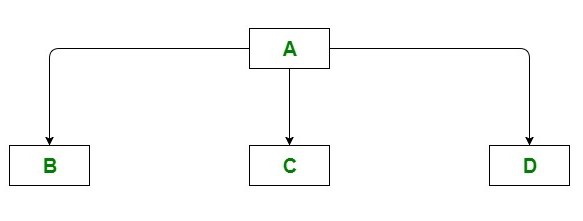C# Program For Hierarchical Inheritance
Last Updated :
30 Sep, 2021
Inheritance is a basic aspect of object-oriented programming. A superclass, also known as a base class, is a class whose members are inherited, whereas a subclass, also known as a derived class, is a class that inherits from a superclass. They are also known as the parent and child classes, respectively. In the same way that a child inherits the traits of his or her parents, and parents inherit the characteristics of their predecessors, inheritance in programming languages works in the same way.
Hierarchical Inheritance
It is a way of transmitting features from a parent class to a base, child, or subclass in terms of technical terms and the object-oriented aspect. The parent class or superclass is the class from which the properties are taken, i.e. the features are inherited. Hierarchical inheritance describes a situation in which a parent class is inherited by multiple subclasses. A type of inheritance in which more than one class is inherited from a single parent or base class is known as hierarchical inheritance. The base class shares many of the same properties as the parent class, especially those that are common in the parent class. A single base class gives rise to many classes. It’s like having several children, each with their own set of characteristics acquired from their parents. For example, In the diagram below, class A acts as the base class(parent class) for the child classes B, C, and D.

Example 1:
The base class in the following example is Father, and the derived classes are ChildFirst and ChildSecond. We’ve created objects from both derived classes and are calling the same base class function.
C#
using System;
public class Father
{
public string FatherName()
{
return "Ravi";
}
}
public class ChildFirst : Father
{
public string ChildDName()
{
return "Rohan";
}
}
public class ChildSecond : Father
{
public string ChildDName()
{
return "Nikhil";
}
}
class GFG{
static public void Main()
{
ChildFirst first = new ChildFirst();
Console.WriteLine("My name is " + first.ChildDName() +
". My father name is " +
first.FatherName() + ".");
ChildSecond second = new ChildSecond();
Console.WriteLine("My name is " + second.ChildDName() +
". My father name is " +
second.FatherName() + ".");
}
}
|
Output
My name is Rohan. My father name is Ravi.
My name is Nikhil. My father name is Ravi.
Example 2:
In the following code, we created three classes: Person, Teacher, and Doctor. In this example, the Person class was inherited by both the Teacher and Doctor classes. A constructor in every class is used to initialize data members. Then we created Teacher and Doctor objects and used TeacherDetails() and DoctorDetails() to produce information for the Teacher and Doctor respectively.
C#
using System;
class Person
{
public string name;
public int aadhar_id;
public int age;
public Person(int aadhar_id, int age, string name)
{
this.aadhar_id = aadhar_id;
this.name = name;
this.age = age;
}
}
class Teacher : Person
{
public int teacher_salary;
public Teacher(int aadhar_id, int salary,
string name, int age) : base(aadhar_id,
age, name)
{
teacher_salary = salary;
}
public void TeacherDetails()
{
Console.WriteLine("teacher ID: " + aadhar_id);
Console.WriteLine("teacher Name: " + name);
Console.WriteLine("teacher Salary: " + teacher_salary);
Console.WriteLine("teacher Age: " + age);
}
}
class Doctor : Person
{
public int doctor_fees;
public Doctor(int aadhar_id, int fees,
string name, int age) : base(aadhar_id,
age, name)
{
doctor_fees = fees;
}
public void DoctorDetails()
{
Console.WriteLine("Doctor ID: " + aadhar_id);
Console.WriteLine("Doctor Name: " + name);
Console.WriteLine("Doctor Fees: " + doctor_fees);
Console.WriteLine("Doctor Age: " + age);
}
}
class GFG{
static public void Main()
{
Teacher t = new Teacher(25054, 50000, "Sanjay", 28);
Doctor d = new Doctor(25045, 750, "Rohit", 32);
t.TeacherDetails();
Console.WriteLine(
"-----------------------------------");
d.DoctorDetails();
}
}
|
Output
teacher ID: 25054
teacher Name: Sanjay
teacher Salary: 50000
teacher Age: 28
-----------------------------------
Doctor ID: 25045
Doctor Name: Rohit
Doctor Fees: 750
Doctor Age: 32
Like Article
Suggest improvement
Share your thoughts in the comments
Please Login to comment...